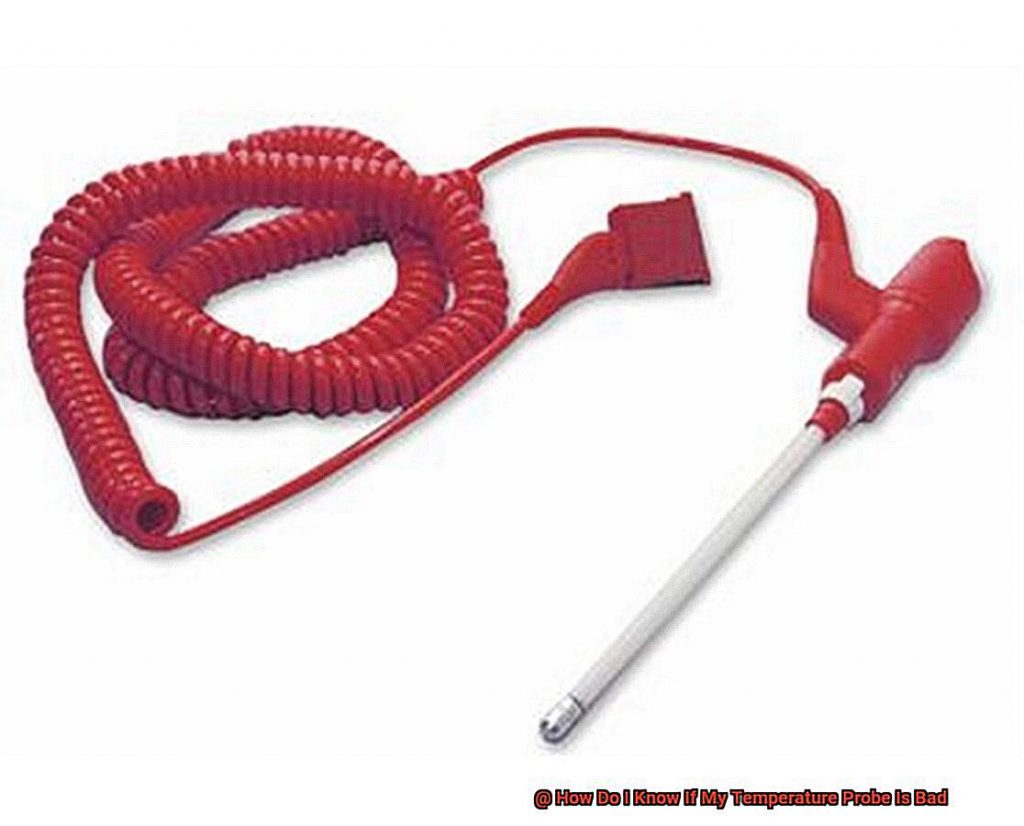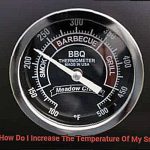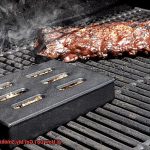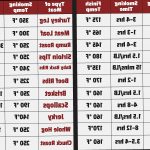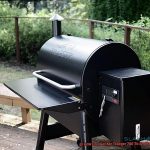Are you frustrated with your food taking longer to cook than usual? Or always coming out overcooked or undercooked, despite following the recipe to a tee? Don’t blame yourself just yet. It’s possible that your temperature probe is the culprit.
A temperature probe is an essential tool in any kitchen, be it at home or in a professional setting. It helps ensure that your dishes are cooked to perfection and safe to eat. But how can you tell if your temperature probe is giving accurate readings?
In this blog post, we’ll explore the telltale signs of a bad temperature probe. We’ll also emphasize the importance of regularly testing your probe to avoid erroneous readings and teach you how to calibrate it for maximum accuracy.
Whether you’re an experienced chef or just starting out, this post is perfect for you. Keep reading to discover how to determine if your temperature probe needs replacing and ensure that every meal is cooked perfectly every time.
Contents
What is a Temperature Probe?
A temperature probe is a type of sensor that measures the temperature of an object or environment. It’s commonly used in grilling and cooking to ensure that your food is cooked at the right temperature, preventing undercooked or overcooked dishes.
Temperature probes come in different forms, including thermocouples, RTDs (resistance temperature detectors), and thermistors. Thermocouples consist of two different metals that generate a voltage when heated, providing fast and rugged readings with a wide temperature range. RTDs are made from a pure metal wire wound around a ceramic or glass core and offer highly accurate readings, but can be more expensive than thermocouples. Thermistors are made from a ceramic or polymer material with a special formulation that changes resistance as the temperature changes, providing highly sensitive and accurate readings but with a limited temperature range.
Temperature probes can come in different shapes and sizes depending on their intended use. For grilling and cooking, they often come as a metal probe with a pointed end to insert into the food being cooked. They can also come as an infrared thermometer, which measures the temperature of an object from a distance.
It’s important to properly maintain your temperature probe to ensure accurate readings and prevent transmitting harmful bacteria to your food. If you notice any signs of damage or wear and tear on the probe itself, it’s likely that the probe is damaged and needs to be replaced. Additionally, if you’re experiencing consistent issues with your temperature probe, such as difficulty getting a reading or inconsistent readings, it may be time to invest in a new probe altogether.
Signs of a Malfunctioning Temperature Probe
As a grill master or cook, you know that precision and accuracy are crucial when it comes to cooking meat. A malfunctioning temperature probe can throw off your game and lead to undercooked or overcooked food, which can be dangerous to consume. That’s why it’s essential to be aware of the signs of a malfunctioning temperature probe.
One of the most apparent signs that your temperature probe is malfunctioning is inaccurate readings. If the temperature readings on your oven or grill don’t match the readings on your temperature probe, then it’s time to take action. For example, if your oven is set to 350°F, but your temperature probe reads 400°F, then you need to replace your probe.
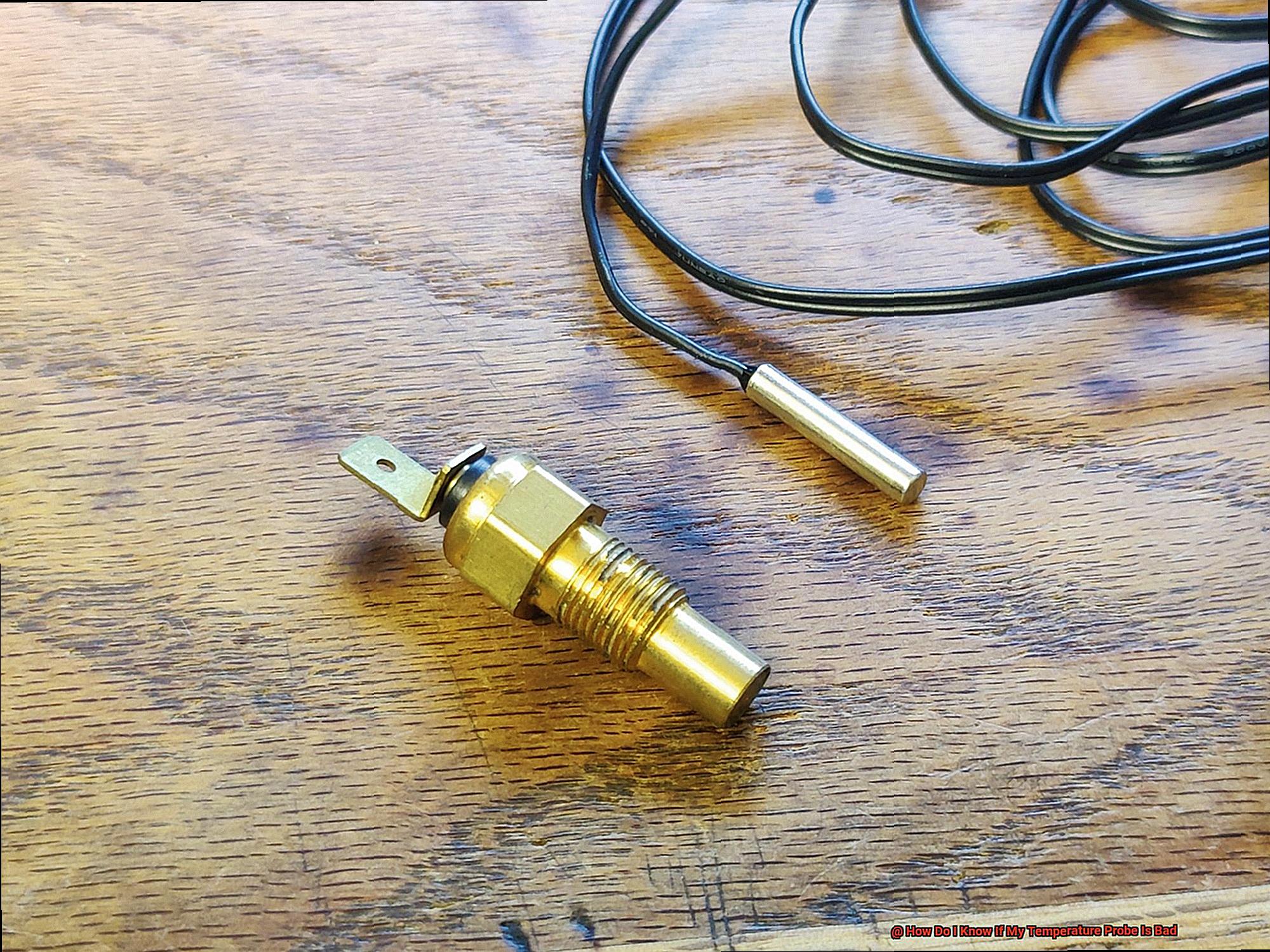
Another sign of a malfunctioning temperature probe is slow response time. A properly functioning temperature probe should give you an accurate reading within seconds. If it takes longer than usual, it could be a sign of a malfunction.
Fluctuating readings are also a common indication that your temperature probe is malfunctioning. Erratic fluctuations could be due to a malfunctioning sensor or wiring issues. This problem can lead to inaccuracies that can cause improperly cooked food, which can be hazardous.
Physical damage is another cause of malfunctions in your temperature probe. Cracks, chips, or exposed wiring can lead to inaccurate readings and compromise the safety of your food. Always inspect your probe before use and replace it if you notice any damage.
Lastly, battery issues can affect the accuracy of the readings. Most probes use batteries for power, so always check the battery level of your temperature probe before use.
Visual Inspection of the Temperature Probe
As a grill master or cook, your temperature probe is an essential tool for ensuring that your meals are cooked to perfection. However, over time, wear and tear can take a toll on your trusty sidekick. That’s where visual inspection comes in.
Visual inspection is the first step in determining the condition of your temperature probe. It allows you to look for any visible signs of damage that could affect its accuracy. Here are the things to look out for:
Firstly, check for cracks, discoloration, wear and tear, or corrosion. These signs indicate that your temperature probe is bad and needs replacement.
Secondly, check the connection between the probe and thermometer. A loose connection can cause inaccurate temperature readings and may indicate a faulty temperature probe. Ensure that the connection is secure and there are no loose wires.
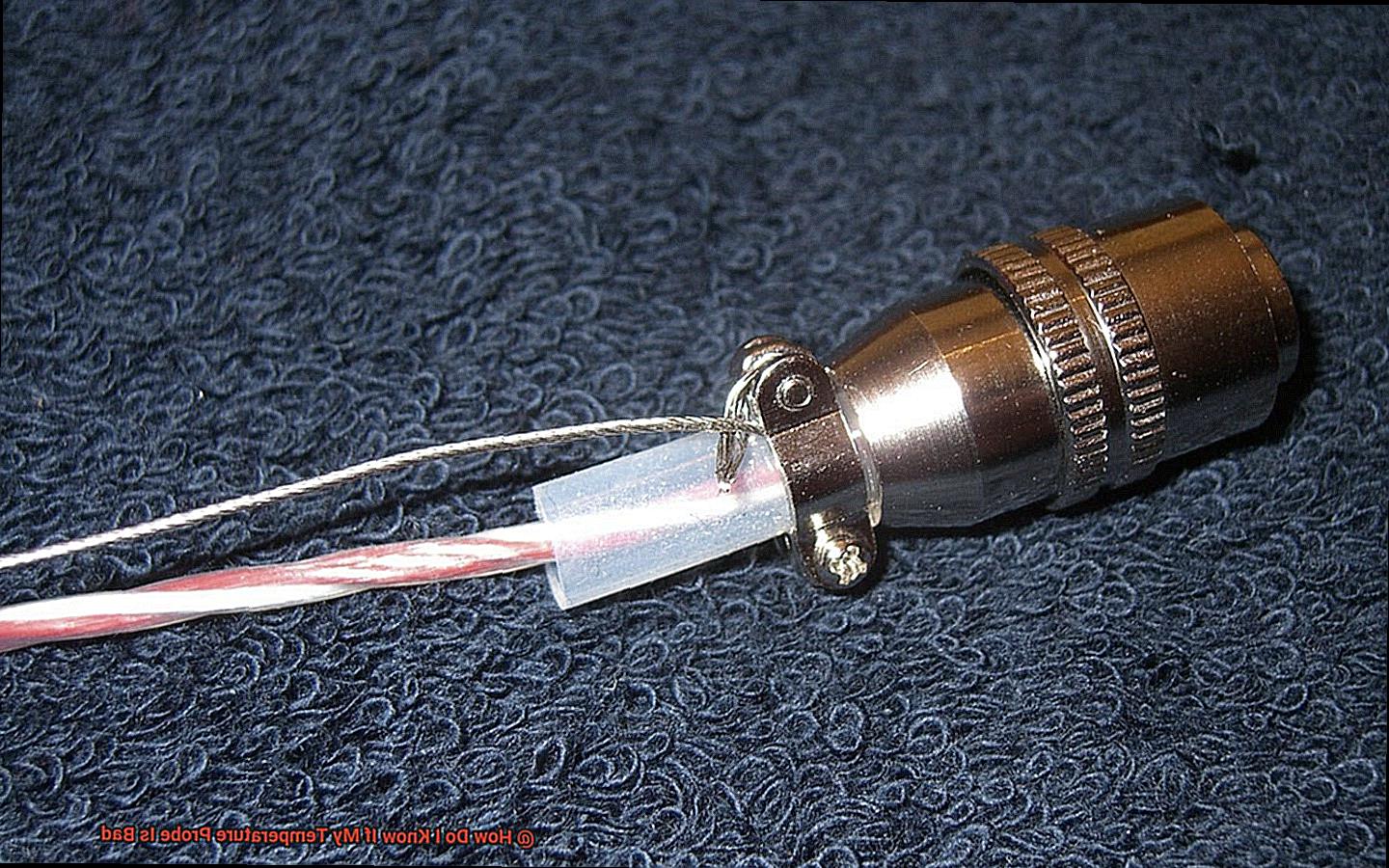
The length of the probe is also crucial during visual inspection. If it has been shortened due to damage or wear and tear, it can affect the accuracy of temperature readings. In this case, replacing the temperature probe with a new one is the best option.
Finally, keeping the temperature probe clean is vital to ensure accurate temperature readings. A dirty or greasy probe can cause false readings and may lead you to believe that your temperature probe is bad when it is not. Regularly cleaning the probe with warm, soapy water and a soft cloth can help prevent this issue.
Maintenance of Your Temperature Probe
Whether you’re a seasoned pro or a newbie to the grilling game, you know how vital a temperature probe is in achieving perfectly cooked meats and veggies. But did you know that maintaining your temperature probe is just as crucial as using it correctly?
Proper maintenance helps ensure accurate readings and safe cooking practices. Here’s why:
- Accuracy: Your temperature probe is only as reliable as its accuracy. If it’s not maintained properly, it can give you false readings, leading to undercooked or overcooked food. Regular cleaning and calibration guarantee that your probe is working at its best.
- Safety: Temperature probes are used to ensure that food reaches safe internal temperatures. A dirty or damaged probe can compromise this and cause foodborne illnesses.
Now that we’ve established why maintenance is essential let’s dive into some tips on how to take care of your temperature probe:
- Clean after each use: After each use, clean your probe thoroughly with soap and water. Rinse it well and dry it completely before storing it.
- Handle with care: Avoid dropping or mishandling your temperature probe as it may damage the fragile components inside.
- Store properly: Store your temperature probe in a dry and cool place away from direct sunlight and heat sources.
- Replace damaged probes: If you notice any cracks, breaks, or signs of wear on your temperature probe, it’s time to replace it with a new one to ensure accurate readings.
- Calibrate regularly: It’s important to calibrate your temperature probe regularly to ensure accurate readings. Follow the manufacturer’s instructions on how to calibrate your specific model.
Consistent Issues with Your Temperature Probe
As we all know, a temperature probe is an indispensable tool for achieving the perfect doneness in our meats. However, when your temperature probe starts acting up, it can be a frustrating experience. That’s why it’s essential to know what to look out for when dealing with consistent issues with your temperature probe.
The first issue on the list is fluctuating readings. If you’re noticing that your temperature readings are inconsistent, it’s a clear sign that your temperature probe is not functioning correctly. This inconsistency can result in over or undercooked meat, which can be a culinary disaster.
Another issue to keep an eye out for is an unresponsive temperature probe. If you’re not getting any readings at all, there might be a faulty connection between the probe and thermometer. This could also lead to inaccurate readings, which can pose serious food safety risks.
Physical damage is another culprit behind temperature probe issues. If your probe is bent or dented, it may not function correctly, leading to inaccurate or no readings at all. It’s crucial to handle your temperature probe with care and store it properly to avoid any physical damage.
To summarize, consistent issues with your temperature probe can put a damper on any grilling experience. Here are some tips to keep in mind:
- Regularly check your temperature probe for any issues.
- Replace your temperature probe as soon as possible if you notice any problems.
- Handle your temperature probe with care and store it properly to avoid any physical damage.
The Benefits of Investing in a New Temperature Probe
A new temperature probe can change everything. Investing in a top-of-the-line temperature probe yields numerous benefits that will revolutionize your grilling game.
First and foremost, accuracy is crucial when it comes to cooking any type of food. A faulty temperature probe can lead to undercooked or overcooked food, which not only affects the taste and texture but can also be a health hazard. With a new temperature probe, you can ensure accurate readings and say goodbye to any potential food safety issues.
But that’s not all. The latest technology and features in modern temperature probes make them an essential tool for any grill master. Wireless connectivity allows you to monitor the temperature of your food remotely using your smartphone or tablet. Plus, some probes even come with multiple sensors that let you monitor the temperature of different parts of your grill or smoker simultaneously.
Investing in a new temperature probe is also a smart financial move. Faulty probes can lead to wasted food and fuel, which adds up over time. By investing in a reliable probe, you’ll save money in the long run while enjoying perfectly cooked food every time.
Finally, a new temperature probe can elevate your culinary skills and take your grilling game to the next level. With accurate temperature readings and advanced features, you can experiment with new cooking techniques and recipes, achieving perfect results every time.
How to Properly Clean and Sanitize Your Temperature Probe
Properly cleaning and sanitizing your temperature probe is essential to ensure accurate readings and safe grilling practices. Here are five sub-sections to help you understand how to clean and sanitize your temperature probe for grilling:
Detach the Probe
Before cleaning, always detach the probe from any electronic components or batteries to prevent damage to the electronics.
Rinse with Water
Rinse the probe under running water, being careful not to get any of the electronic components wet. This will remove any loose debris or food particles.
Scrub with Soap and Water
Using a soft-bristled brush or sponge, gently scrub the probe with soap and water. Avoid using abrasive materials that could scratch the probe or damage any electronic components. This will remove any remaining dirt and grease.
Sanitize
Sanitizing is important to kill any bacteria that may be present on the probe. One effective method is to soak the probe in a mixture of water and bleach for at least 1 minute. The ratio of water to bleach should be about 10:Alternatively, you can use a commercial sanitizer specifically designed for foodservice equipment. Follow the manufacturer’s instructions for dilution and proper use.
Rinse and Dry
After sanitizing, rinse the probe again under running water to remove any traces of bleach or sanitizer. Dry it thoroughly with a clean cloth before storing it in a clean, dry location until you are ready to use it again.
Conclusion
As we wrap up, it’s clear that a temperature probe is a crucial device for any kitchen. Whether you’re a professional chef or a home cook, using a temperature probe ensures your dishes are cooked to perfection and safe to eat. However, when your temperature probe fails, it can lead to frustration and even dangerous undercooked or overcooked food.
To determine if your temperature probe is in good condition, start with a visual inspection. Check for cracks, discoloration, wear and tear, or corrosion. Additionally, ensure the connection between the probe and thermometer is secure with no loose wires. Regular cleaning after each use with soap and water is also necessary to prevent false readings caused by dirt or grease.
Investing in a new temperature probe yields numerous benefits such as accuracy, wireless connectivity for remote monitoring, multiple sensors for simultaneous monitoring of different parts of your grill or smoker. You’ll save money in the long run while enjoying perfectly cooked food every time. Lastly, make sure you properly clean and sanitize your temperature probe after each use to ensure accurate readings and safe grilling practices.
In summary, don’t overlook the importance of maintaining your temperature probe’s accuracy. With these tips in mind, you’ll be able to identify signs of a bad temperature probe and take action before it causes any issues.

